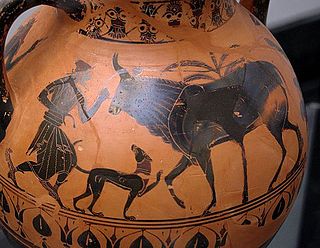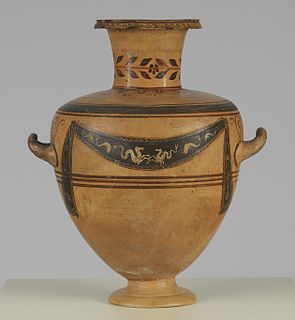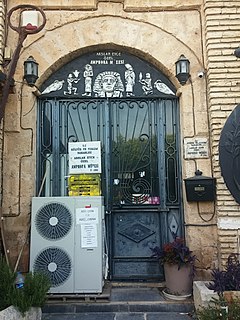
An amphora is a type of container of a characteristic shape and size, descending from at least as early as the Neolithic Period. Amphorae were used in vast numbers for the transport and storage of various products, both liquid and dry, but mostly for wine. They are most often ceramic, but examples in metals and other materials have been found. Versions of the amphorae were one of many shapes used in Ancient Greek vase painting.

The Affecter was an Attic black-figure vase painter, active in Athens around 550 to 530 BCE.
Geometric art is a phase of Greek art, characterized largely by geometric motifs in vase painting, that flourished towards the end of the Greek Dark Ages, circa 900 BC – 700 BC. Its center was in Athens, and from there the style spread among the trading cities of the Aegean. The Greek Dark Ages are also called the Geometric period in reference to this characteristic pottery style, although the historical period is much longer than the art-historical period, being circa 1100 – 800 BC. The vases had various uses or purposes within Greek society, including, but not limited to, funerary vases and symposium vases.

Pottery was produced in enormous quantities in ancient Rome, mostly for utilitarian purposes. It is found all over the former Roman Empire and beyond. Monte Testaccio is a huge waste mound in Rome made almost entirely of broken amphorae used for transporting and storing liquids and other products – in this case probably mostly Spanish olive oil, which was landed nearby, and was the main fuel for lighting, as well as its use in the kitchen and washing in the baths.

Tyrrhenian amphorae are a specific shape of Attic black-figure neck amphorae. Tyrrhenian amphorae were only produced during a short period, about 565 to 550 BC. They are ovoid in shape and bear striking decorations. The handle is usually decorated with a lotus-palmette cross or vegetal tendrils. It always terminates in a red-painted ridge. The vase body is painted with several friezes. The uppermost of these, on the shoulder, is usually especially notable. It often contains mythological scenes, but the first erotic motifs in Attic vase painting also occur here. Unique motifs include the sacrifice of Polyxene. Often, the figures are explained by added inscriptions. The other friezes, usually two to three in number, are often decorated with animals. At times, a frieze is replaced with a vegetal band.

Group E was a group of Attic vase painters of the black-figure style. They were active between 560 and 540 BC.

A Nikosthenic amphora is a type of Attic vase invented in the late 6th century BC by the potter Nikosthenes, aimed specifically for export to Etruria. Inspired by Etruscan Bucchero types, it is the characteristic product of the Nikosthenes-Pamphaios workshop.
The Princeton Painter was an Attic black-figure vase painter, active in the third quarter of the sixth century BC, just after Group E. His real name is not known.

The Rycroft Painter was an Attic late black-figure vase painter, active in the final decade of the sixth century BC. His real name is not known.

The term Class of Cabinet des Médailles 218, or Class of Cab. Méd. 218 or Class of C.M. 218 describes both a group of Attic black-figure vase painters, and a type of vase they produced. They belong to the final third of the sixth century BC.
The Hypobibazon Class was a group of Attic black-figure vase painters and a type of vase. They belong to the period around 510 BC.

The term Three Line Group describes a group of Attic black-figure vase painters, as well as a type of vase. They belong to the last quarter of the sixth century BC.

Bilingual vase painting is a special form of ancient Greek vase painting. The term, derived from linguistics, is essentially a metaphorical one; it describes vases that are painted both in the black-figure and in the red-figure techniques. It also describes the transitional period when black-figure was being gradually replaced in dominance by red-figure, basically the last quarter of the 6th and the very beginning of the 5th century BC. Their appearance may be due to the initial uncertainty of the market for the new red-figure style, although that style subsequently became dominant rather fast.

The Northampton Group was a stylistic group of ancient Greek amphorae in the black-figure style.

The modern scholarly term Hâdra vases describes a group of Hellenistic painted hydriai. Apart from late Panathenaic prize amphorae, it is the only substantial group of figurally or ornamentally painted vases in the Greek world of the 3rd century BC.

Submycenaean pottery is a style of ancient Greek pottery. It is transitional between the preceding Mycenaean pottery and the subsequent styles of Greek vase painting, especially the Protogeometric style. The vases date to between 1030 and 1000 BC.

Konya Archaeological Museum is a state archaeological museum in Konya, Turkey. Established in 1901, it had been relocated twice before moving to its present location in 1962. One of the most prominent displays in the museum is of sarcophagi and other antiquities from the ancient city of Çatalhöyük. Other exhibits relate to the Neolithic, Bronze Age, Iron Age, Classical, Hellenistic, Roman and the Byzantine periods; artifacts consist of ceramic ware, stone and bronze wares, ornaments and inscriptions. A prominent display is of a marble sarcophagus of the 3rd century BC with elaborate sculpting events depicting the life of Hercules. In the outer open yard of the museum, there are a number of small sculptures, sarcophagi, column heads, and epigraphy.

Arslan Eyce Private Amphora Museum, also known as Taşucu Amphora Museum, is a maritime archaeology museum dedicated to amphora in Taşucu, southern Turkey.















